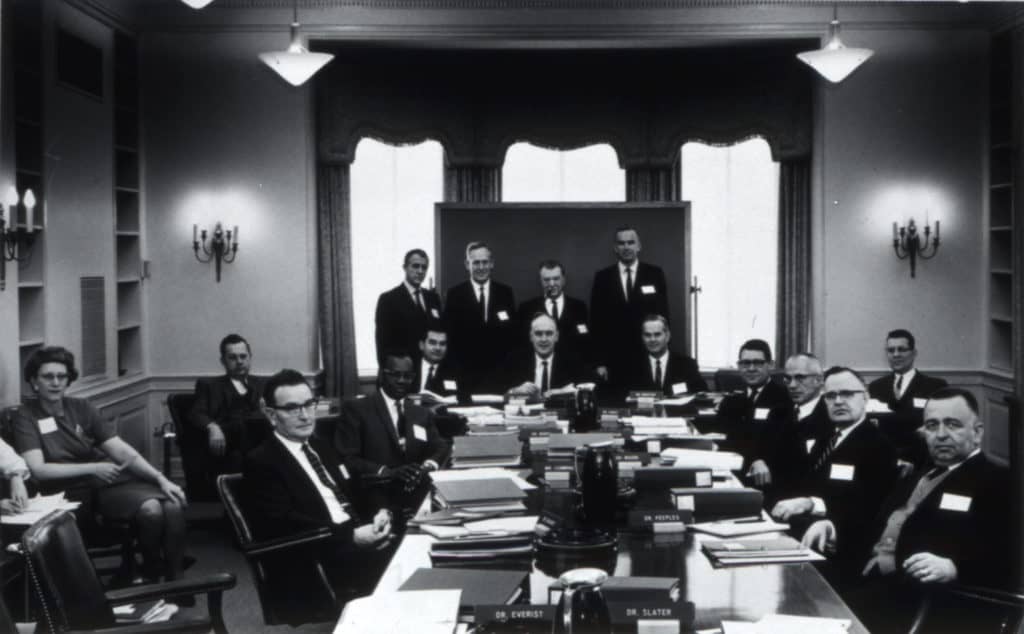
The current state of Emergency Medical Systems (EMS) in the United States is one of strict guidelines and standardized education all under the umbrella of national and state organizations, as anyone who has gone through training understands. Of course, EMS was not always this organized.
The National Registry of Emergency Medical Technicians (NREMT) was founded in 1970 to regulate the standards for EMS personnel when ten years previously, in 1960, only six states had standard education for rescuers, and less than half of all EMS personnel had any kind of formal training. In the time between 1964 and 1974, major advancements were made in prehospital care due to a perfect storm of political and social movements.
The Regional Medical Programs (RMPs) of the late 60s and early 70s coordinated research efforts and rapidly improved medical knowledge by better utilizing the systems that were already in place. Without the bipartisan efforts of Congress, it’s possible that the boom of medical knowledge and technology we experienced in such a short time would have taken many more years; however, EMS textbooks tend to gloss over RMPs entirely, mentioning only the National Highway Safety Act of 1966. Maybe that’s because advancements in prehospital care were only a small part of the success of RMPs and their significance in the history of health care in America.
In the early 60s, some major health concerns came to light. Statistics showed that two thirds of Americans at the time would be diagnosed with and possibly die from heart disease, cancer, or stroke. At the time, patient care for these problems was poor, as it was for trauma. More vehicles were on the roads than ever before, and as a result, automobile crashes were on the rise. There was a need for quick and effective transport and treatment of those injured on the road.
President Johnson designated a group, headed by Dr. Michael DeBakey, to develop a program to battle these issues. They advised the government to help create regional groups that would improve research efforts, education, and ultimately, patient care. Due to the cost of creating new facilities and the public’s foreseen fear of being sent away for treatment, Congress proposed that the program should work with facilities and health care systems that were already in place. And thus, in 1965, RMPs were born, although they took a little time to become established.
In December 1967, 61 RMPs had been designated but only four were active. Only three years later, 54 RMPs were operational. Some people in the medical research community were initially uneasy about the government being involved in their efforts. There was fear that RMPs would take credit for advancements or try to control the projects. People also took issue with the sharing of information with other institutions.
The language of the programs allowed for RMPs to be funded by grants, which let them serve areas that had common needs. This regional jurisdiction was an unusual decision by the federal government, but contributed greatly to the success of RMPs. Regions were not limited by state or county lines, which better served the RMPs goal of improved patient care through shared knowledge and education.
For example, the Missouri RMP set up a communication link between the physicians and cardiologists there and a medical center in South Carolina that allowed for the remote reading of EKGs. Of course, that kind of technology is common now, but it was a huge advancement at the time. All this sharing of new technology meant that a patient who would once have been referred to a university for treatment could now receive proper care at their local hospital. Healthcare was becoming more of a level playing field.
The Northlands RMP, which covered the entire state of Minnesota, spurred great strides during the time the program was active. It connected Minnesota’s two most powerful medical institutions at the time: the Mayo Clinic and the University Medical School. However, the focus was not meant to be on those organizations, but how to connect them with the region as a whole.
Rural areas were in need of better care. Both Mayo and the University rose to this challenge. Mayo encouraged physicians in the region to attend their seminars on standard techniques and practices. This allowed for laboratory tests and X-rays taken locally to be used for a trustworthy diagnosis and not need to be repeated once the patient arrived at Mayo. The University began to speed up referral results and change their entire concept of medical school, believing that education should continue after graduation and throughout a physician’s entire career. They called on community physicians to join them in revamping the curriculum.
Meanwhile, the Highway Safety Act of 1966 was created in part as a response to the National Academy of Sciences National Research Council’s scathing report of the current state of EMS. They cited the lack of any treatment protocols or trained personnel, inefficient transportation and evaluation of prehospital care, outdated equipment and communications, and the passing of blame by political establishments. The Highway Safety Act specified government involvement to improve all aspects of EMS and allowed for penalties to states that did not comply. It just so happened that RMPs were already expanding training for healthcare professionals including Emergency Medical Technicians (EMTs).
The ties that RMPs had to early EMS improvements occurred simultaneously with broad outreach efforts. While some projects seemed destined to only affect health care professions like physicians and nurses, the education for many programs stemmed out to include local fire departments and ambulance attendants. Training for the Community Stroke Programs made it possible for a fireman to not only advise on the most appropriate medical facility for stroke victims, but also to provide some level of care for the patient in the meantime. Of course, plans for this program went even further. It called for people of qualifying professions to be able to make improvements to homes of those handicapped by strokes by understanding the needs of the patients.
The Alabama chapter of the RMPs was actively training ambulance staff on improved cardiac patient care and was involved in creating a radio network to connect ambulances with hospitals and fire and police departments. Again, just a very small piece of an overwhelming movement to dramatically improve patient care. A movement that found itself up against impounded funding under the Nixon administration in 1972.
Every two years RMPs needed to be re-approved for funding, since they were a government program. When Congress voted emphatically to continue RMPs, newly appointed Secretary of Health Education, and Welfare, Caspar Weinberger, lobbied against them. Nixon impounded RMPs funds and RMPs sued to have the money released. The historical power of the President to impound funds appropriated by Congress was removed later due to Nixon’s abuse of the power.
The funds were eventually released and RMPs continued until Congress passed the National Health Planning and Resources Development Act in 1975, which combined the efforts of RMPs with various other programs into local organizations. This move was in part due to how cheaply things could now be performed in community hospitals.
It’s hard to single out any one reason why RMPs disappeared about as quickly as they developed. Just as it’s hard to pick a singular accomplishment of the programs when they were so far reaching, effectively spurring a health care revolution. The US National Library of Medicine seems to keep the only major record of RMPs. Thousands of documents spanning every aspect of the programs – a perfectly preserved time capsule giving us a glimpse at the infrastructure that has been forgotten underneath years of continuing advancements and standardization of care that may not have been possible without that first regional effort.
Sources & More Information
The Formation of the Emergency Medical Services System. Shah, Manish N. MD. March 2006. https://www.ncbi.nlm.nih.gov/pmc/articles/PMC1470509/
Regional medical programs (revised) (1995). Video with transcript. https://collections.nlm.nih.gov/vplayer?pid=nlm:nlmuid-101472445-vid
Impoundment of appropriated funds. https://en.wikipedia.org/wiki/Impoundment_of_appropriated_funds
The Highway Safety Act of 1966. Historical Highlights. https://history.house.gov/Historical-Highlights/1951-2000/The-Highway-Safety-Act-of-1966/
The Regional Medical Programs Collection. Organizational Period (October 1965 to September 1968): Documents. U.S. National Library of Medicine. https://profiles.nlm.nih.gov/ps/retrieve/Narrative/RM/p-nid/96/p-docs/true
Bulletin of the History of Medicine 77.1. Fox, Daniel M. Spring 2003. https://search.proquest.com/openview/4d4bac43b7c2bce8251b1f83e9f7d967/1?pq-origsite=gscholar&cbl=34417
A Study of the Regional Medical Program. Vol II & III. Arthur D. Little, Inc. 1970. https://profiles.nlm.nih.gov/ps/access/RMACGE.pdf
Packard, John M. MD. Regional Medical Programs Alabama. https://profiles.nlm.nih.gov/ps/access/RMAANR.pdf#xml=https://profiles.nlm.nih.gov:443/pdfhighlight?uid=RMAANR&query=%28ambulance%29


